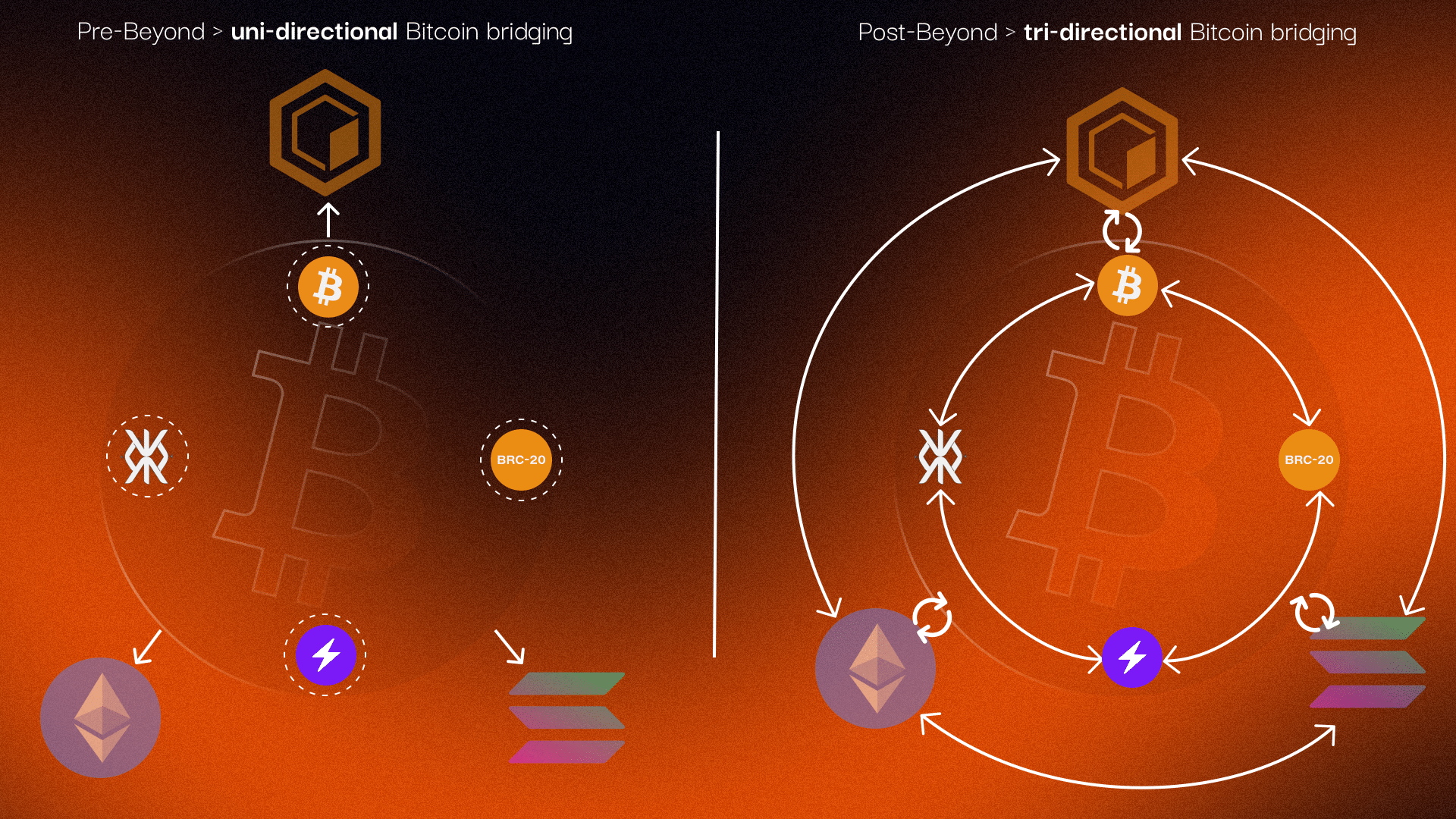Frequently Asked Questions (FAQs)
New to Beyond, or looking for more insights? Please meet the Beyond Intern, our custom AI (GPT) assistant. Available for both text and voice conversations through the OpenAI mobile app, our intern offers detailed information about all things Beyond—and "he" is available 24/7!
For a human touch instead, we recommend joining our vibrant Discord community.
Why Bitcoin? Why Beyond?
Bitcoin's unmatched decentralization, security, and global recognition have positioned it as the leading driving force of the entire blockchain industry for over a decade, with a market valuation over US$1 trillion at present. However, the lack of infrastructure to support a real on-chain economy has resulted in Bitcoin being overshadowed by newer blockchains with advanced interoperability and DeFi capabilities—until now, that is, with significant game-changing breakthroughs having been achieved recently in 2024.
Within this context, Beyond exists to provide the infrastructure required to build a multi-trillion-dollar future where Bitcoin evolves from just a store of value ("digital gold") into a fully functional on-chain economy and ecosystem.

What is Beyond?
Beyond is a pioneering native Bitcoin interoperability protocol that enables seamless cross-chain messaging and asset bridging between different blockchain ecosystems and Bitcoin L1 (including Bitcoin-to-Bitcoin transactions across its multiple token standards).
The mission behind Beyond is to provide the necessary infrastructure to enable thousands of Bitcoin-powered decentralized applications, accelerating a future where Bitcoin becomes the powerhouse for DeFi on a global scale. This is the rationale behind our tagline: Enabling the Bitcoin On-Chain Economy.
What can I do with Beyond? How is it different?
Beyond helps transform Bitcoin into a fully interoperable and programmable blockchain. It acts not only as the first bi-directional bridge between the +$1 trillion Bitcoin market and the +$1 trillion altcoin ecosystem, but goes further by creating the first-ever tri-directional bridge, integrating the different parts of the Bitcoin ecosystem also from within. This is not an incremental step; it’s a game-changer, unlocking liquidity across more than +$2 trillion in assets.
The first version (Beyond V1) introduces a suite of unique functionalities designed for both users and developers:
- Omnichain Interoperability: Connected via LayerZero to the entire blockchain industry.
- Bi-Directional Bridging: Move digital assets such as $USDT or $ETH
toandfromBitcoin L1. - Native Token Support: Transfer Bitcoin assets like $ORDI or $SATS
toandfromall supported networks. - Native Protocols Support: Platforms that integrate Beyond can tap into the broader industry's infrastructure and liquidity pools (for example, a Bitcoin-native lending protocol may use Uniswap to perform a liquidation).
- Multi-Standard Support: Choose your preferred Bitcoin token standard:
BRC-20,Runes,TAP... - Cross-Standard Conversion: Switch between standards in a single transaction, without leaving Bitcoin!
- Universal BTC Wrapper: Access all major BTC wrapper solutions—now more interoperable, liquid, and globally accessible (even in chains without an original wrapper) via Beyond.
How is Beyond built and designed?
For a technical overview, please check our Architecture section. In short, the Beyond team is committed to setting and adhering to the highest quality assurance standards in the industry, focusing on:
- Prime Functionality: Best-in-class permissionless infrastructure, enabling optimal efficiency over your assets.
- User-Centric Design: Tailored user experience with 360° coverage of your needs.
- Uncompromising Security: Check our in-depth explainer to learn all the safety measures implemented.
Why use LayerZero?
LayerZero emerged as the optimal choice for Beyond's interoperability requirements due to its robust security features and comprehensive benefits. The OFT Standard by LayerZero currently stands as the most widely used and adopted standard across all existing options, offering Beyond unmatched network compatibility and liquidity.
From a security perspective, LayerZero has been extensively battle-tested in real-world applications, facilitating over US$50 billion in transaction volume, with dozens of networks integrated, and usage by hundreds of protocols and thousands of assets. The LayerZero protocol has also been extensively audited, and it features the world's largest bug bounty program, worth US$15 million.
The commitment of the LayerZero team to lead the field of blockchain interoperability and to broaden their impact further solidifies their role as a pivotal partner in Beyond's ecosystem.
How is DeFi even possible on the Bitcoin L1?
With the introduction of inscriptions in 2023, we've seen a groundbreaking development that enables secure and unique identification and use of digital assets (such as tokens and NFTs) on the Bitcoin network. This breakthrough marked the beginning of a new era for digital asset innovation, leveraging Bitcoin’s unparalleled reliability and security infrastructure to improve the global economy.
What are Inscriptions and Ordinals?
-
Inscriptions: Imagine you could take a tiny piece of Bitcoin—not just any piece, but a very specific one—and mark it with a digital sticker. These stickers could be anything: a picture, a piece of text, a snippet of a song, or even a small program. This is exactly what inscriptions allow you to do. They let users attach a wide array of digital information directly onto Bitcoin’s smallest units, called satoshis, similar to how you might stick a unique label onto individual pages of a book.
-
Ordinals: And how do we make sure each of these "book pages" are unique? This is where ordinals come into play. Ordinals are like giving every single satoshi, or book page, a serial number. Just like how every dollar bill has a unique number, every satoshi gets its own identifier, making it distinguishable from all others no matter who they belong to. This numbering system makes it possible to track, trade, and collect any satoshi, especially those with special stickers (inscriptions) attached to them.
Ordinals allow us to identify and track each satoshi, while inscriptions let us attach meaningful data to them. Together, they transform these satoshis from mere fractions of a Bitcoin into unique, programmable digital artifacts. This novel use introduces a whole new dimension to the Bitcoin network, leveraging its security and decentralization to support a flourishing ecosystem without altering Bitcoin’s foundational principles.